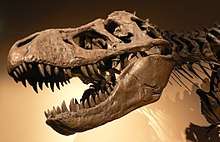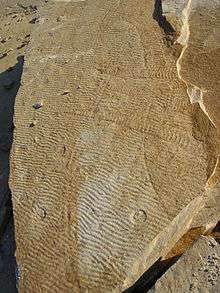Lagerstätte
| Part of a series on |
| Paleontology |
|---|
 |
|
Organs and processes |
|
History of paleontology |
|
Branches of paleontology |
|
Paleontology Portal Category |

A Lagerstätte (German: [ˈlaːɡɐˌʃtɛtə], from Lager 'storage, lair' Stätte 'place'; plural Lagerstätten) is a sedimentary deposit that exhibits extraordinary fossils with exceptional preservation—sometimes including preserved soft tissues. These formations may have resulted from carcass burial in an anoxic environment with minimal bacteria, thus delaying decomposition. Lagerstätten span geological time from the Neoproterozoic era to the present. Worldwide, some of the best examples of near-perfect fossilization are the Cambrian Maotianshan shales and Burgess Shale, the Devonian Hunsrück Slates and Gogo Formation, the Carboniferous Mazon Creek, the Jurassic Solnhofen limestone, the Cretaceous Santana and Yixian formations, and the Eocene Green River Formation.
Types
Palaeontologists distinguish two kinds:[1]
- Konzentrat-Lagerstätten (concentration Lagerstätten) are deposits with a particular "concentration" of disarticulated organic hard parts, such as a bone bed. These Lagerstätten are less spectacular than the more famous Konservat-Lagerstätten. Their contents invariably display a large degree of time averaging, as the accumulation of bones in the absence of other sediment takes some time. Deposits with a high concentration of fossils that represent an in situ community, such as reefs or oyster beds, are not considered Lagerstätten.
- Konservat-Lagerstätten (conservation Lagerstätten) are deposits known for the exceptional preservation of fossilized organisms or traces. The individual taphonomy of the fossils varies with the sites. Conservation Lagerstätten are crucial in providing answers to important moments in the history and evolution of life. For example, the Burgess Shale of British Columbia is associated with the Cambrian explosion, and the Solnhofen limestone with the earliest known bird, Archaeopteryx.
Preservation

Konservat-Lagerstätten preserve lightly sclerotized and soft-bodied organisms or traces of organisms that are not otherwise preserved in the usual shelly and bony fossil record; thus, they offer more complete records of ancient biodiversity and behavior and enable some reconstruction of the palaeoecology of ancient aquatic communities. In 1986, Simon Conway Morris calculated only about 14% of genera in the Burgess Shale had possessed biomineralized tissues in life. The affinities of the shelly elements of conodonts were mysterious until the associated soft tissues were discovered near Edinburgh, Scotland, in the Granton Lower Oil Shale of the Carboniferous.[2] Information from the broader range of organisms found in Lagerstätten have contributed to recent phylogenetic reconstructions of some major metazoan groups. Lagerstätten seem to be temporally autocorrelated, perhaps because global environmental factors such as climate might affect their deposition.[3]
A number of taphonomic pathways may produce Lagerstätten. The following is an incomplete list:
- Orsten-type and Doushantuo-type preservations preserve organisms in phosphate.
- Bitter Springs-type preservation preserves them in silica.
- Carbonaceous films are the result of Burgess Shale-type preservation
- Pyrite preserves exquisite detail in Beecher’s trilobite-type preservation.
- Ediacaran-type preservation preserves casts and moulds with the aid of microbial mats.
Important Konservat-Lagerstätten
The world's major Lagerstätten include:
| Precambrian | ||
| Bitter Springs | 1000–850 Mya | South Australia |
| Doushantuo Formation | 600–555 Mya | Guizhou Province, China |
| Mistaken Point | 565 Mya | Newfoundland, Canada |
| Ediacara Hills | 550–545? Mya | South Australia |
| Cambrian | ||
| Maotianshan Shales (Chengjiang) | 515 Mya | Yunnan Province, China |
| Sirius Passet | 518 Mya | Greenland |
| Emu Bay Shale | 513 Mya | South Australia |
| Kaili Formation | 513–501 Mya | Guizhou province, south-west China |
| Blackberry Hill | ~510–500 Mya | Central Wisconsin, US |
| Burgess Shale | 508 Mya | British Columbia, Canada |
| Wheeler Shale (House Range) | 504 Mya | Western Utah, US |
| Marjum Formation | 502 Mya | Western Utah, US |
| Weeks Formation | 500 Mya | Western Utah, US |
| Kinnekulle Orsten and Alum Shale | 500 Mya | Sweden |
| Ordovician | ||
| Fezouata Formation | about 485 Mya | Draa Valley, Morocco |
| Beecher's Trilobite Bed | 460? Mya | New York, US |
| Walcott-Rust Quarry | about 455? Mya | New York, US |
| Soom Shale | 450? Mya | South Africa |
| Silurian | ||
| Wenlock Series | ~425 Mya | Herefordshire, England, UK |
| Devonian | ||
| Rhynie chert | 400 Mya | Scotland, UK |
| Hunsrück Slates (Bundenbach) | 390 Mya | Rheinland-Pfalz, Germany |
| Gogo Formation | 380 Mya (Frasnian) | Western Australia |
| Miguasha National Park | 370 Mya | Québec, Canada |
| Canowindra, New South Wales | 360 Mya | Australia |
| Carboniferous | ||
| Bear Gulch Limestone | 320 Mya | Montana, US |
| Joggins Fossil Cliffs | 315 Mya | Nova Scotia, Canada |
| Linton Diamond Coal Mine | 312 Mya | Ohio, US |
| Mazon Creek | 310 Mya | Illinois, US |
| Montceau-les-Mines[4][5] | 300 Mya | France |
| Hamilton Quarry | 300 Mya | Kansas, US |
| Permian | ||
| Mangrullo Formation[6] | about 285–275 Mya (Artinskian) | Uruguay |
| Triassic | ||
| Madygen Formation | 230 Mya | Kyrgyzstan |
| Ghost Ranch | 205 Mya | New Mexico, US |
| Jurassic | ||
| Holzmaden/Posidonia Shale | 180 Mya | Württemberg, Germany |
| Mesa Chelonia[7] | 164.6 Mya | Shanshan County, China |
| La Voulte-sur-Rhône | 160 Mya | Ardèche, France |
| Karabastau Formation | 155.7 Mya | Kazakhstan |
| Solnhofen Limestone | 145 Mya | Bavaria, Germany |
| Canjuers Limestone | 145 Mya | France |
| Cretaceous | ||
| Las Hoyas | about 125 Mya (Barremian) | Cuenca, Spain |
| Yixian Formation | about 125–121 Mya | Liaoning, China |
| Xiagou Formation | about 120–115? Mya (mid-Apt.) | Gansu, China |
| Crato Formation | about 117 Mya (Aptian) | northeast Brazil |
| Haqel/Hadjula/al-Nammoura | about 95 Mya | Lebanon |
| Santana Formation | 108–92 Mya | Brazil |
| Smoky Hill Chalk | 87–82 Mya | Kansas and Nebraska, US |
| Ingersoll Shale | 85 Mya | Alabama, US |
| Auca Mahuevo | 80 Mya | Patagonia, Argentina |
| Zhucheng | 66 Mya | Shandong, China |
| Eocene | ||
| Fur Formation | 55–53 Mya | Fur, Denmark |
| London Clay | 54–48 Mya | England, UK |
| McAbee Fossil Beds | 52.9 ± 0.83 Mya | British Columbia, Canada |
| Green River Formation | 50 Mya | Colorado/Utah/Wyoming, US |
| Klondike Mountain Formation | 49.4 ± .5 Mya | Washington, US |
| Monte Bolca | 49 Mya | Italy |
| Messel Oil Shale | 49 Mya | Hessen, Germany |
| Quercy Phosphorites Formation[8] | 25–45 Mya | South-Western France |
| Oligocene–Miocene | ||
| Dominican amber | 30–10 Mya | Dominican Republic |
| Riversleigh | 25–15 Mya | Queensland, Australia |
| Miocene | ||
| Clarkia fossil beds | 20-17 Mya | Idaho, US |
| Barstow Formation | 19–13.4 Mya | California, US |
| Ashfall Fossil Beds | 12–13? Mya | Nebraska, US |
| Pleistocene | ||
| Mammoth Site | 26 Kya | South Dakota, US |
| Rancho La Brea Tar Pits | 40–12 Kya | California, US |
| Waco Mammoth National Monument | 65–51 Kya | Texas, US |
| El Breal de Orocual | 2.5–1 Mya | Monagas, Venezuela |
| El Mene de Inciarte | 25.5–28 Kya | Zulia, Venezuela |
See also
- List of fossil sites (with link directory)
References
- ↑ The term was originally coined by Adolf Seilacher in: Seilacher, A. (1970). "Begriff und Bedeutung der Fossil-Lagerstätten: Neues Jahrbuch fur Geologie und Paläontologie". Monatshefte (in German). 1970: 34–39.
- ↑ Briggs et al. 1983; Aldridge et al. 1993.
- ↑ Retallack, G. J. (2011). "Exceptional fossil preservation during CO2 greenhouse crises?". Palaeogeography, Palaeoclimatology, Palaeoecology. 307: 59–74. doi:10.1016/j.palaeo.2011.04.023.
- ↑ Garwood, Russell J.; Sharma, Prashant P.; Dunlop, Jason A.; Giribet, Gonzalo (2014). "A Paleozoic Stem Group to Mite Harvestmen Revealed through Integration of Phylogenetics and Development". Current Biology. 24 (9): 1017–23. doi:10.1016/j.cub.2014.03.039. PMID 24726154. Retrieved April 17, 2014.
- ↑ Perrier, V.; Charbonnier, S. (2014). "The Montceau-les-Mines Lagerstätte (Late Carboniferous, France)". Comptes Rendus Palevol. 13 (5): 353–67. doi:10.1016/j.crpv.2014.03.002.
- ↑ Piñeiro, G.; Ramos, A.; Goso, C. S.; Scarabino, F.; Laurin, M. (2012). "Unusual Environmental Conditions Preserve a Permian Mesosaur-Bearing Konservat-Lagerstätte from Uruguay". Acta Palaeontologica Polonica. 57 (2): 299–318. doi:10.4202/app.2010.0113.
- ↑ Wings, Oliver; Rabi, Márton; Schneider, Jörg W.; Schwermann, Leonie; Sun, Ge; Zhou, Chang-Fu; Joyce, Walter G. (2012), "An enormous Jurassic turtle bone bed from the Turpan Basin of Xinjiang, China", Naturwissenschaften, 114: 925–35, doi:10.1007/s00114-012-0974-5
- ↑ Lalloy, F.; Rage, J. C.; Evans, S.E.; Boistel, R.; Lenoir, N.; Laurin, M. (2013). "A re-interpretation of the Eocene anuran Thaumastosaurus based on microCT examination of a 'mummified' specimen". PLoS ONE. 8: 1–11. doi:10.1371/journal.pone.0074874. PMC 3783478. PMID 24086389.
Further reading
- Penney, D. (ed.) 2010. Biodiversity of Fossils in Amber from the Major World Deposits. Siri Scienfic Press, Manchester, 304 pp.
- "Fossil Lagerstätten". Department of Earth Sciences, University of Bristol. 2003. Retrieved 2005-11-21. – A catalogue of sites of exceptional fossil preservation produced by MSc palaeobiology students at University of Bristol's Department of Earth Sciences.
- Orr, Patrick J.; David J. Siveter (1 January 2000). "Three-dimensional preservation of a non-biomineralized arthropod in concretions in Silurian volcaniclastic rocks from Herefordshire, England". Journal of the Geological Society. 157 (1): 173–86. doi:10.1144/jgs.157.1.173. Retrieved 2006-10-26.